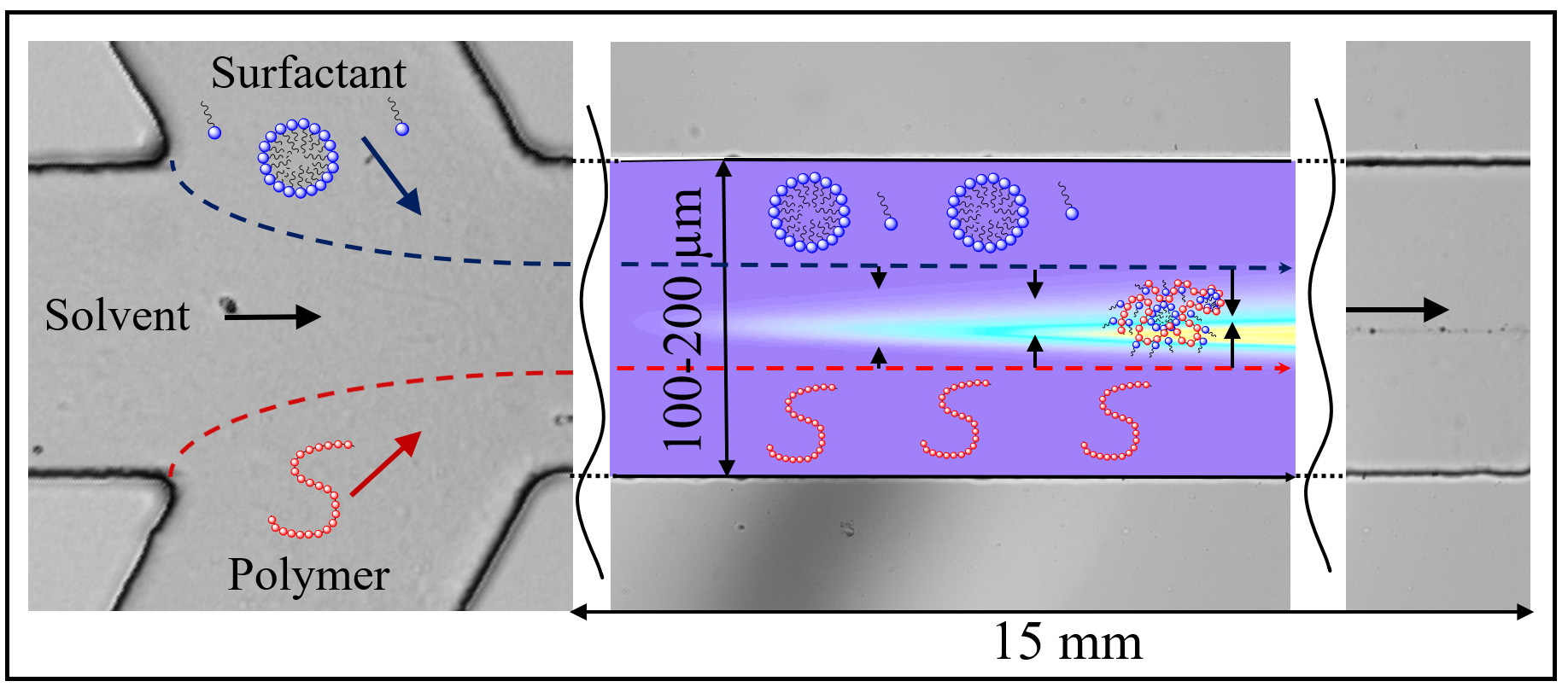This work is focused on the research in interactions of polymers and surfactants in a non-equilibrium microfluidic confinement. The main factor of our research is that microfluidic convection-diffusion conditions bring up multiple additional factors that affect complexation in reacting polymer and surfactant flows. These factors allow proceeding synthesis of non-equilibrium polymer-surfactant complexes that are impossible to produce in macroscopic conditions. Factors that are represented as dimensionless parameters come as convenient tools to predict locations of reaction fronts in a microchannel control the phase behavior of confined polymer-surfactant solutions and sizes of associates.
Polymer-surfactant nanoparticles were synthesized from Polydiallyldimethylammonium chloride (PDADMAC) and Sodium dodecyl sulfate (SDS).
For macroscopic experiments, PDADMAC and SDS solutions were mixed in different ratios.
For microfluidic experiments, PDADMAC and SDS solutions were infused into microfluidic devices by syringe pumps. For images recording were used Levenhuk D320 optical microscope at 10X magnification. Microfluidic chips were fabricated by standard photolithography technique using Sylgard 184 polydimethylsiloxane. The selected design for microchips was the T-sensor (3 inputs for solutions of polymer and surfactant and a solvent). The width of microchannels is 200 μm.
PDADMAC-SDS systems were initially characterized in macroscopic conditions. With increasing level of surfactant concentration, polymer-surfactant nanoparticles form in solutions. The solutions become turbid and this turbidity increases with more added surfactant. The nanoparticles are represented by aggregates of macromolecules with bound surfactant ions. According to dynamic light scattering measurements, the hydrodynamic radius of such complexes is approximately 100-200 nm. When surfactant-polymer concentration ratio reaches 0.4-0.5, precipitates form in solutions and turbidity decreases. Such a behavior is the result of formation of insoluble associates through neutralization of charges on PDADMAC macroion by additives of oppositely charged SDS ions and aggregation of the resulting hydrophobic complexes. Precipitation occurs when the residual charges on a macromolecular chain are not sufficient to keep macromolecules in aqueous solution.
The results of macroscopic characterization contributed to planning microfluidic experiments. Polymer-surfactant nanoparticles were synthesized in microchannels by radial diffusive mixing of parallel laminar flows of polymer and surfactant solutions separated by a solvent flow. The solutions of complexes with surfactant-to-polymer ratio Z=0.1, 0,3, and 0,5 were also mixed with surfactant solutions in the experiments analogous to those with the polymer flows.
Microfluidic studies of PDADMAC and SDS complexation revealed considerable differences between the results of experiments performed in macroscopic conditions and in microfluidic confinement. In opposite of macroscopic experiments, microfluidic processes involving interactions of polymers and surfactants occur in non-equilibrium conditions. The reaction of complexation takes place after mutual diffusion of PDADMAC and SDS after junction in the flow of solvent. Accumulation of the reaction product in the narrow region of the reaction front results in precipitation even if the respective polymer-surfactant system is homogeneous. As the result, the straight line of precipitate forms in microchannels. The location of this line depends on diffusion coefficients of the reagents.
Dynamic light scattering studies of PDADMAC-SDS solutions taken at the microchannel output demonstrate that the hydrodynamic radii of associates vary in the range of 100-200 nm that is in agreement with macroscopic experiments. The sizes of aggregates can be reproducibly controlled in this range by varying the flowrates of the reagents and the solvent.


